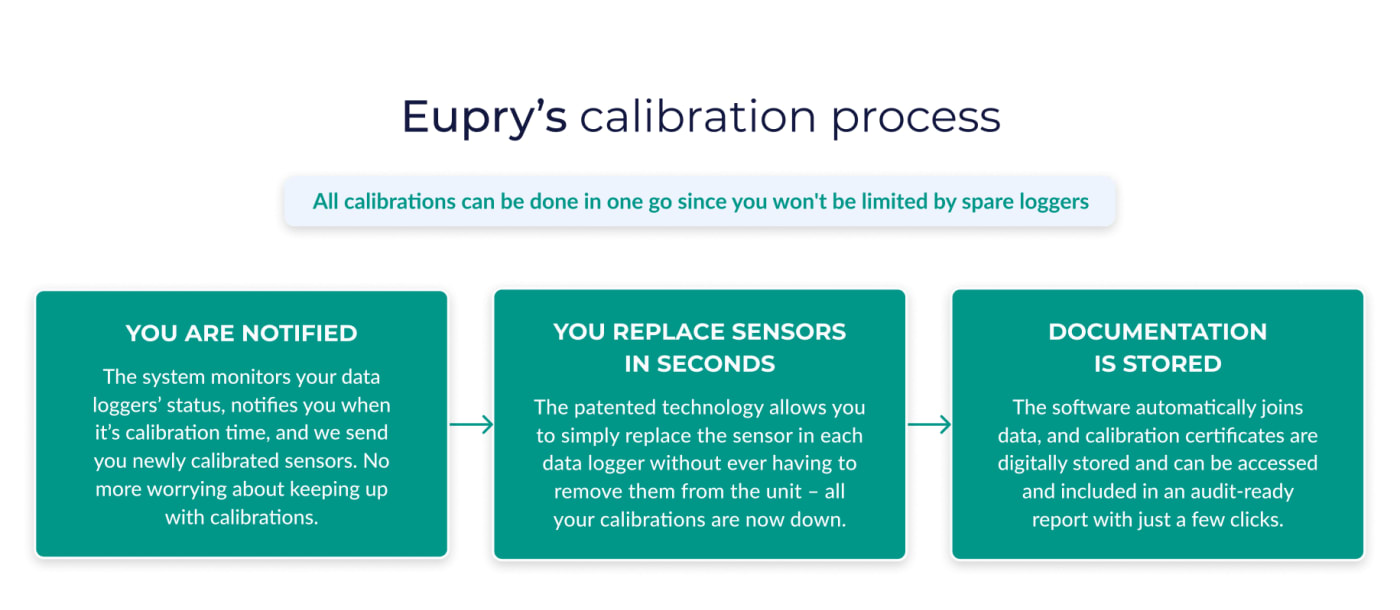
8 temperature calibration components you should have ready for an audit

Estimated reading time: 3 minutes
It is a time-old question.
Well, maybe not. But we do get it a lot:
Which calibration elements should you have ready in case of an audit of your temperature compliance?
Here are 8 elements you should have on hand to showcase your compliance when preparing for an audit involving the calibration of temperature data loggers:
The 8 temperature calibration elements to have ready for your next audit
- Your schedule: Establish a calibration schedule based on the manufacturer’s recommendations, industry standards, and regulatory requirements. This schedule should outline the frequency of calibration for each data logger, considering factors such as usage, environmental conditions, and criticality of measurements.
- Your traceability docs: Maintain traceability documentation that demonstrates a clear chain of calibration of data loggers or sensors. This includes information about the calibration laboratory, standards, equipment, and procedures. Traceability ensures that your calibration process is reliable and can be validated.
- Your procedures: Develop (and document) detailed calibration procedures for your temperature and humidity data loggers. They should outline all the steps of calibration including specific environmental conditions, reference standards, or measurement techniques. Make sure your procedures align with industry best practices and relevant standards.
- Your reference equipment: If you have an in-house calibration lab, make sure to maintain appropriate calibration equipment including calibrated reference temperature and humidity sensors. Simplified put, these reference standards should have a higher level of accuracy and stability than the data loggers being calibrated and the method used needs to be substantiated, tested, etc. You also need to regularly check and calibrate your reference standards to ensure their accuracy.
- Your certificates: Obtain and maintain up-to-date calibration certificates for all your temperature and humidity data loggers. These certificates provide evidence that your instruments have been calibrated by an accredited laboratory and are accurate within specified tolerances.
- Your records: Keep meticulous records of all calibration activities. This includes documenting the date, time, and results of each calibration as well as any adjustments or repairs made. Maintain a calibration log for each data logger noting when it was last calibrated and when the next calibration is due. These records serve as evidence of compliance during an audit.
- Your audit trail: Establish an audit trail for your calibration process. This involves documenting any changes or modifications made to the data loggers or the calibration process itself. Include details about who performed the changes, the reason for the modification, and any validation or verification performed afterward. Note: A digital calibration and monitoring solution will automatically keep track of changes, certificates, and all other relevant records and provide you with instant access to all data to make complying with an auditor’s requests quick and efficient.
- Your training records: Ensure that everyone involved in the process is trained and competent in performing calibration activities. Provide training on the proper handling of data loggers, calibration procedures, and the use of calibration equipment. Document the training records to demonstrate competence.
By having these calibration elements ready, you can confidently demonstrate to auditors that your temperature and humidity data loggers are accurately calibrated, providing reliable measurements that comply with requirements and standards.
Also read: What kind of temperature calibration should I choose?
Calibration done in minutes - and all in one go
With automated temperature compliance and patent-pending calibration technology, data logger calibration can be done quickly and simultaneously (no more being limited by spare loggers).
At Eupry, we are all about doing temperature compliance in a smarter way – and a pillar of this is rethinking the way calibration of data loggers is traditionally done.
The result is a patented calibration technology that changes the nature of calibration to provide you with a quicker and more reliable solution.


As a bonus, all calibration certificates are digitally stored together with all other temperature compliance-related data – locate deviations, temperature records, changes, and calibration certificates in one place and generate it into an audit-ready report with just a few clicks.
